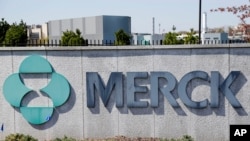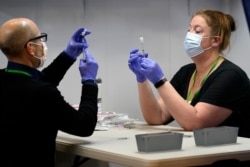U.S. pharmaceutical giant Merck has agreed to help manufacture rival Johnson & Johnson’s new coronavirus vaccine to help speed production of millions of new doses of the single shots to inoculate more Americans in the coming months, White House officials said Tuesday.
Johnson & Johnson has encountered unexpected production problems, even as it won emergency use approval last weekend for the vaccine. The company has manufactured 3.9 million doses so far, but says it is on pace to produce 100 million doses by the end of June.
President Joe Biden said Tuesday that the U.S. will have enough vaccines for all Americans in May, calling the agreement between the two pharmaceutical companies a “major step forward.
“There is a light at the end of the tunnel,” Biden said, but cautioned that “it’s not over yet.”
Asked when Americans could expect a return to a “normal” life resembling pre-pandemic times, he said he could not give a sure answer, but hoped it would be “before this time next year.
Officials familiar with the deal say Merck will use two sites in the U.S., one to help make the vaccine and the other to provide “fill-finish” services, the final stage in the production process in which the vaccine is placed in vials and packaged for distribution, according to The Washington Post.
The Merck agreement with its drug-making rival could sharply increase the number of doses Johnson & Johnson could make on its own, the officials said.
Merck failed in its efforts to develop its own coronavirus vaccine, but the company has made vaccines for a century. It is the sole U.S. supplier of the combination childhood vaccine that protects against measles, mumps and rubella. It developed Gardasil, which protects against the human papillomavirus, while the Food and Drug Administration approved its Ebola vaccine in 2019.
With the approval of the single-shot Johnson & Johnson vaccine, the U.S. now has three medical treatments to fight the spread of the virus, along with two-shot regimens produced by drug makers Pfizer-BioNTech and Moderna.
After the FDA’s approval of the Johnson & Johnson vaccine, the company said it would immediately ship nearly 4 million doses in the United States, and a total of 20 million by the end of March. That is 17 million less than originally expected although the company still says it expects to markedly increase its production pace in coming months.
A top Johnson & Johnson executive told Congress last week that it hopes to manufacture 1 billion doses worldwide by the end of 2021.
The mass inoculations in the U.S. are first targeting health care workers, older people living in nursing homes, such essential personnel as police and firefighters, teachers, people 65 and older and those with underlying health problems.
U.S. health officials are hoping that the country's sense of normalcy might return by the end of 2021, but that is dependent on the widespread vaccination of millions of adults and later, possibly children.
So far, 75 million vaccine doses have been administered to about 15% of the country’s adult population, with half that percentage receiving both shots of the two-shot Pfizer and Moderna regimens. About 1.7 million shots are being administered daily.
The spread of the coronavirus has slowed in the U.S. But 50,000 or 60,000 new cases are still being diagnosed each day and another 1,500 people or so are dying.
The U.S. has totaled more than 514,000 deaths and more than 28.6 million infections, both higher totals than in any other country, according to Johns Hopkins University.






